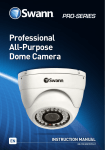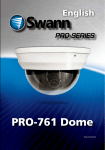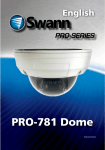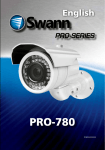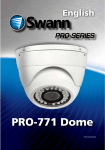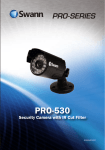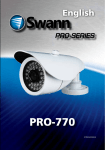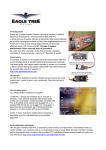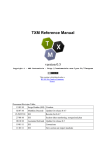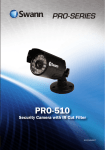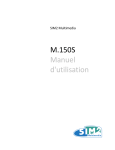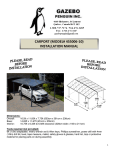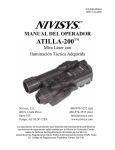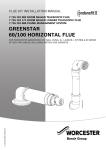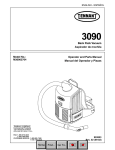Download Super Wide-Angle Security Camera - Free-Instruction
Transcript
Super Wide-Angle Security Camera EN INSTRUCTION MANUAL MWABCAM150514T About the Camera ENGLISH Congratulations on your purchase of this PRO-CAM camera from Swann! You’ve chosen well: we think this is one of the finest CCTV video cameras available. The PRO-CAM is great for monitoring a wide open space whilst maintaining a high level of detail, even at night - it can see up to 30m/100ft in the dark. Placement Guide The PRO-CAM has a 3.6mm wide-angle lens built-in which allows it to see around 75 degrees horizontally. What does this mean for you when placing it? • You will be able to see a really wide area. If it’s mounted high up in a square corner, 15.3m you’ll probably be able to see along both walls. You’ll be 51ft able to monitor a large area with only one camera. • Things may look further away than they really are. Anything further than a few meters (ten feet or so) from the camera may appear to be too small for the level of detail you require. • 75° 10m 33ft Vertical and horizontal lines might appear curved when they near the edge of the camera’s view. This is normal, and it’s the side effect of cramming so much viewing area onto one screen. The PRO-CAM is great for monitoring rooms or areas as wide as, or wider than, they are long. For really wide areas, you may need a second camera. Typically, it is best mounted in a corner looking across and down into the room, so that it can look over intervening obstacles. The higher the ceiling the camera is mounted on, the more it will be able to see and the harder it’ll be for an intruder to access the camera or interfere with it. Tips & Tricks 2 • Try to aim the camera at an area which is evenly lit, as objects or people in shadows near brightly lit objects are very hard to see. • It’s better to have the camera in the shade looking into the light than vice-versa. • Avoid having bright light sources in your image. This includes the obvious (such as the sun or an artificial light source) but also things such as reflections. Cars are notorious for reflected light sources, as are buildings with a lot of windows, mirrors and so forth. The camera mounts onto a flat, vertical surface using screws. The surface must have sufficient strength to hold the camera. Materials such as hardwood, brick or masonry are good options, and we’ve included all the gear you’ll need to mount it there (except the tools - sorry, you’ll still need your own drill). You can mount the camera onto a metal surface, but you’ll need to supply your own mounting hardware. To mount the camera: • ENGLISH Mounting and Installing Using the holes on the camera stand as a guide, mark the locations on your wall to drill. Make sure the wall is thick and strong enough that you won’t drill through it. The three screw holes marked in red • • • If the wall is masonry, brickwork or similar, use the provided wall plugs. If the wall is made of wood, then the camera can be screwed directly onto the wall. Ensure that the cable is protected from the weather. The camera is weatherproof, but the cable (particularly the power and video-out plugs) is not. Once the camera has been mounted, ensure that it is securely fixed in place. The camera is vandal resistant, but that won’t help if an intruder can remove the whole camera! Positioning your Cables • When running your cable, try to avoid bending it at sharp angles. • Don’t put your cable near live electrical wiring. AC electricity generates radio “noise” which can interfere with the signal from your camera. Weatherproofing • The PRO-CAM is built to be weather resistant. It’ll stand up to getting wet but it’s not intended to be underwater all the time. When mounting the camera, ensure that it’s not in a location where water is likely to pool or build up over time. • Long term exposure to direct sunlight will adversely affect the camera. Over time, the infrared and ultraviolet radiation will eventually begin to degrade the integrity of the plastic cover, reducing transparency and making it brittle (and, therefore, more vulerable to vandalism or accidental damage). Basically, put it in the shade! 3 Connection Guide ENGLISH 2 3 1 4 6 5 1. Connect the camera’s DC and BNC cables to the extension cable, twist the BNC connector to lock it together securely. 2. (Optional) If you intend to use the OSD controller, connect the camera’s green RS485 plug to the extension cable. You may first need to attach the RS485 plug to the wires on the cables as shown in the diagram above. 3. Connect the the other end of the BNC extension cable to an unused channel on the back of your DVR and twist the connector to lock it on securely. 4. Connect the extension cable’s DC socket to one end of the power splitter cable. 5. (Optional) To use the OSD controller, plug the extension cable’s RS485 plug (note red connector to A/+ and black connector to B/- on the controller socket) and the other end of the power splitter to the OSD controller’s RS485 port and DC in power jack. 6. Connect the power splitter cable to the power adapter, and plug the power adapter into a wall outlet. Note: Once the camera is set up and working well it is a good idea to wrap some electrical tape around the connections between the camera cable and the BNC extension cable to keep moisture out and preserve the electrical integrity of the connection. 4 Problem: At night, all I see is white. Solution: The camera is most likely looking through a window. At night, the infrared light the camera uses to see in the dark can ‘bounce back’ off a reflective surface (such as glass, water, spider webs, some ceramics and so on) and effectively blind the camera. If you want to see outside, mount the camera outside - we made it weatherproof for a reason! ENGLISH Troubleshooting Problem: I see only a blank screen where my image should be. Solution: Check the wiring to the camera, and ensure the camera is being supplied power from the included power adapter. Try using a different video lead, or connecting the camera to a different television or monitor. Be sure there are no devices interrupting your signal, such as a DVR or VCR that isn’t outputting the signal correctly. Problem: I can’t see anything at night. Solution: The maximum range of the night vision is just that, the maximum range. If there’s nothing in this range, you won’t see anything. Also, some dark objects (like the proverbial black cat) may not reflect enough light to be seen except as a silhouette if the background is brighter. Some objects which can easily be seen in visible light don’t reflect much infrared light. Advanced Feature: On Screen Display (OSD) The OSD is an optional use, advanced feature that allows you to change settings for: Wide Dynamic Range (reduces the difference between light and dark areas of a scene) 3D Noise Reduction (reduces digital image “noise” in low light images) Back Light Compensation (adjusts the image if strong light source is in the scene background) Auto White Balance (another way of adjusting the image to compensate for different lighting and colour conditions in a camera scene) Numerous other image tuning and camera setting options. The camera will work perfectly well if you never attach the OSD controller - it will regulate all its settings automatically and will suit most applications. The OSD controls are many and varied so if you would like to make some changes or have a particular need for your camera that requires some fine tuning, simply read the OSD guide included in your pack or you can download the guide to the OSD from our website: www.swann.com/osdpro 5 Helpdesk / Technical Support Details Swann Technical Support All Countries E-mail: [email protected] Telephone Helpdesk USA toll free AUSTRALIA toll free 1-800-627-2799 1300 138 324 USA Exchange & Repairs NEW ZEALAND toll free 1-800-627-2799 (Option 1) 0800 479 266 (M-F, 9am-5pm US PT) UK 0203 027 0979 Limited Warranty Terms & Conditions Swann Communications warrants this product against defects in workmanship and material for a period of one (1) year from it’s original purchase date. You must present your receipt as proof of date of purchase for warranty validation. Any unit which proves defective during the stated period will be repaired without charge for parts or labour or replaced at the sole discretion of Swann. The end user is responsible for all freight charges incurred to send the product to Swann’s repair centres. The end user is responsible for all shipping costs incurred when shipping from and to any country other than the country of origin. The warranty does not cover any incidental, accidental or consequential damages arising from the use of or the inability to use this product. Any costs associated with the fitting or removal of this product by a tradesman or other person or any other costs associated with its use are the responsibility of the end user. This warranty applies to the original purchaser of the product only and is not transferable to any third party. Unauthorized end user or third party modifications to any component or evidence of misuse or abuse of the device will render all warranties void. By law some countries do not allow limitations on certain exclusions in this warranty. Where applicable by local laws, regulations and legal rights will take precedence. For Australia: Our goods come with guarantees which cannot be excluded under Australian Consumer Law. You are entitled to a replacement or refund for a major failure and for compensation for any other reasonably foreseeable loss or damage. You are also entitled to have the goods repaired or replaced if the goods fail to be of acceptable quality and the failure does not amount to major failure. FCC Verification This equipment has been tested and found to comply with the limits for Class B digital device, pursuant to part 15 of the FCC Rules. These limits are designed to provide reasonable protection against harmful interference in a residential installation. This equipment generates, uses and can radiate radio frequency energy and, if not installed and used in accordance with the instructions, may cause harmful interference to radio or television reception, which can be determined by turning the equipment off and on, the user is encouraged to try to correct the interference by one or more of the following measures: Reorient or relocate the receiving antenna Increase the separation between the equipment and the receiver • Connect the equipment into an outlet on a circuit different from that to which the receiver is connected • Consult the dealer or an experienced radio/TV technician for help WARNING: Modifications not approved by the party responsible for compliance could void user’s authority to operate the equipment. © Swann Communications 2014 Cámara de seguridad con gran angulo ES MANUAL DE INSTRUCCIONES Acerca de la cámara ¡Felicitaciones por su compra de esta PRO-CAM de Swann! Ha elegido bien: creemos que es una de las mejores cámaras de video de CCTV disponibles. La cámara PRO-CAM es ideal para supervisar un amplio espacio abierto y a la vez mantener un alto nivel de detalle, incluso por la noche: se puede ver hasta 30 m / 100 pies en la oscuridad. Guía de colocación ESPAÑOL La cámara PRO-CAM posee una lente de ángulo amplio de 3,6 mm incorporada que le permite ver casi 75 grados de forma horizontal. ¿Qué significa esto para usted al colocarla? • Podrá ver un área realmente amplia. Si se monta en un rincón elevado y recto, probablemente podrá ver hacia 15.3m ambas paredes. Podrá supervisar un área de tamaño 51pies considerable con una sola cámara. • Los objetos pueden parecer más alejados de lo que realmente se encuentran. Todo objeto que se encuentre 10m 75° más allá de unos pocos metros (aproximadamente diez 33pies pies) de la cámara puede parecer demasiado pequeño para el nivel de detalle requerido. • Las líneas verticales y horizontales pueden parecer curvas cuando se aproximan al extremo de la vista de la cámara. Esto es normal, es un efecto secundario de ajustar un área de visión tan grande en una sola pantalla. La cámara PRO-CAM es ideal para supervisar habitaciones o áreas más anchas que largas. Para áreas realmente amplias, puede que necesite una segunda cámara. Se coloca mejor en un rincón en una posición elevada mirando hacia abajo, de tal forma que pueda ver por encima de los obstáculos que puedan interponerse. Asimismo, cuanto más alto se monta la cámara, más difícil será para un intruso acceder a la cámara o interferir con ella. Sugerencias y trucos 8 • Intente apuntar la cámara hacia un área con luz uniforme. Los objetos o personas en sombras cercanas a objetos fuertemente iluminados con muy difíciles de ver. • Es mejor tener la cámara en la sombra mirando hacia la luz que lo opuesto. • Al colocar el cable, intente evitar doblarlo en ángulos pronunciados. Esto puede interceptar el flujo de señal y degradar la calidad de sus imágenes. Si el cable se debe doblar, intente que la curva sea lo más gradual posible. Instalación de la cámara La cámara se monta sobre una superficie plana y vertical usando tornillos. La superficie debe ser lo suficientemente fuerte como para sostener la cámara. Materiales tales como madera dura, ladrillos o mampostería son buenas opciones y hemos incluido los elementos que necesitará para montarla (con excepción de las herramientas... Lo sentimos, necesitará su propio taladro). Puede montar la cámara sobre una superficie metálica, pero necesitará sus propios elementos de montaje. • Utilizando los orificios del soporte de la cámara como guía, marque las ubicaciones en la pared para perforar. Asegúrese de que la pared sea lo suficientemente gruesa y resistente como para no atravesarla. • Si la pared es de mampostería, ladrillos o similar, use los tacos provistos. Si la pared es de madera, entonces la cámara puede atornillarse directamente en la pared. Asegúrese de que el cable quede protegido de la intemperie. La cámara es impermeable, pero el cable (en particular el enchufe de electricidad y de salida de video) no lo es. Una vez que se ha montado la cámara, asegúrese de que quede firmemente asegurada en su lugar. La cámara es resistente al vandalismo, ¡pero ello no ayudará si un intruso puede extraer la cámara entera! Los tres orificios de los tornillos marcados en rojo • • ESPAÑOL Para montar la cámara Ubicación de los cables • Al colocar el cable, intente evitar doblarlo en ángulos pronunciados. • No coloque el cable cerca de cables con electricidad. La electricidad CA genera “ruidos” de radio que pueden interferir con la señal de la cámara. A prueba de intemperie • La PRO-CAM es a prueba de intemperie. Resiste mojarse ocasionalmente, pero no está hecha para que la use debajo del agua todo el tiempo. Al montar la cámara, asegúrese de que no sea en un lugar donde se acumule o se forme agua con el tiempo. • La exposición prolongada y directa al sol perjudicará la cámara. Con el tiempo, la radiación infrarroja y ultravioleta perjudicará la cubierta plástica, lo que disminuirá su transparencia y la hará quebradiza (y por lo tanto, más vulnerable a actos de vandalismo o a daños accidentales). Básicamente, ubíquela a la sombra! 9 Guía de Conexión 2 3 1 4 6 5 ESPAÑOL 1. Conecte los cables DC y BNC de la cámara al cable de extensión. 2. (Opcional) Si intenta utilizar el controlador OSD, conecte el enchufe verde RS485 al cable de extensión. Podría necesitar acoplar primero el enchufe RS485 a los alambres en los cables como se muestra en el siguiente diagrama. 3. Conecte el cable de extensión BNC a un canal abierto en la parte trasera de su DVR. 4. Conecte el enchufe DC del cable de extensión a un extremo del cable divisor de potencia. 10 5. (Opcional) Para utilizar el controlador OSD, conecte el enchufe del cable de extensión RS485 y el otro extremo del divisor de potencia al puerto RS485 del controlador OSD y la hembra del DC. 6. Conecte el cable divisor de potencia al adaptador, y enchufe el adaptador a la salida de pared. Solución de problemas Problema: De noche, sólo se ve una imagen blanca. Solución: La cámara probablemente está enfocando una ventana. De noche, la luz infrarroja que usa la cámara para ver en la oscuridad puede “rebotar” en una superficie reflexiva (como el vidrio, agua, telas de araña, algunas cerámicas, etc.) y efectivamente cegar la cámara. Si desea ver hacia afuera, monte la cámara en el exterior, ¡por algo la hicimos impermeable! Problema: Sólo veo una pantalla en blanco donde debería haber imagen. Solución: Verifique el cableado de la cámara y asegúrese de que la cámara reciba alimentación del adaptador de energía provisto. Intente usar otro cable de video o conectar la cámara a un televisor o monitor diferente. Asegúrese de que no haya dispositivos que interfieran con la señal, tales como una grabadora de DVD o video que no emite la señal correctamente. Función avanzada: Visualización en pantalla (OSD) La OSD es una función opcional, avanzada y recomendada sólo para usuarios experimentados. La cámara trabajará perfectamente bien si nunca acopla el controlador OSD - regulará todas sus funciones automáticamente. ESPAÑOL Problema: No veo nada de noche. Solución: El rango máximo de visión nocturna es exactamente eso, el rango máximo. Si no hay nada en este rango, no verá nada. Asimismo, algunos objetos oscuros (como el famoso gato negro) pueden no reflejar la suficiente luz como para ser vistos excepto como una silueta si el fondo es más brillante. Algunos objetos que pueden verse fácilmente con luz visible no reflejan mucha luz infrarroja. Los controles OSD son muchos y variados, y simplemente no hay espacio suficiente en este manual para cubrirlos. Puede descargar una guíadetallada de nuestro sitio web: www.swann.com/osdpro 11 Detalles del servicio de asistencia / Soporte Técnico Soporte técnico Swann Correo electrónico para todos los países: [email protected] Teléfono del servicio de asistencia Número de llamada sin cargo EE.UU. Número de llamada sin cargo AUSTRALIA 1-800-627-2799 1300 138 324 Cambio y reparaciones EE. UU. Número de llamada sin cargo NUEVA ZELANDA 1-800-627-2799 (Opción 1) (L-V, 9am-5pm EE. UU. PT) 0800 479 266 Reino Unido 0203 027 0979 Información sobre la garantía Swann Communications garantiza este producto por defectos de fabricación y material,por un período de un (1) año a partir de la fecha original de compra. Usted deberá presentar su recibo como prueba de la fecha de compra para validar la garantía. Cualquier unidad que se compruebe defectuosa durante el período antes citado será reparada sin cobrar los repuestos o la mano de obra, o será sustituida, a discreción exclusiva de Swann. La reparación o sustitución se garantizará por noventa días o por el período que falte de la garantía original de un año, el que resulte más largo de los dos. El usuario final asume los costos de fletes incurrido para enviar el producto a los centros de reparación de Swann. El usuario final se responsabiliza de los costos de envío en que incurran cuando envía desde y hacia cualquier país distinto al país de origen. La garantía no cubre daños accidentales, circunstanciales o que resulten del uso o la imposibilidad de utilizar este producto. Cualquier costo asociado con la adaptación o remoción de este producto por parte de un vendedor o de otra persona, o cualquier costo asociado con el uso del mismo son responsabilidad del usuario final. Esta garantía aplica exclusivamente al comprador original del producto, y no es transferible a terceros. Si el usuario final o un tercero hacen modificaciones no autorizadas a cualquier componente o si hay evidencia de mal uso o abuso del dispositivo, se anularán todas las garantías. Verificación de la FCC: NOTA: Este equipo ha sido probado y se encontró que cumple con los límites para aparatos digitales Clase B, de acuerdo con la parte 15 de la FCC. Estos límites están diseñados para proveer protección razonable contra interferencia dañina en una instalación residencial. Este equipo genera, usa y puede irradiar energía de radiofrecuencia, si no se instala y se usa de acuerdo con las instrucciones, puede causar interferencia dañina en la recepción de radio o televisión, lo cual se puede determinar encendiendo y apagando el equipo, se alienta al usuario intentar corregir la interferencia mediante una o más de las siguientes medidas: • Reoriente o cambia de ubicación la antena receptora. • Incremente la separación entre el equipo y el receptor. • Conecte el equipo a una toma en un circuito diferente al que está conectado el receptor. • Consulte al distribuidor o a un técnico en radio/televisión con experiencia por ayuda. Estos dispositivos cumplen con la parte 15 del Reglamento de la FCC. El funcionamiento está sujeto a las dos siguientes condiciones: (1) Estos aparatos no deben causar interferencia dañina, y (2) Estos aparatos deben aceptar cualquier interferencia recibida, incluyendo interferencia que pueda causar un funcionamiento no deseado © Swann Communications 2014 Caméra de sécurité à angle super large FR MANUEL D’UTILISATION À propos de la caméra Félicitations pour votre achat de cette caméra PRO-CAM de Swann! Vous avez fait un bon choix : nous croyons que c’est une des meilleures caméras vidéo CCTV sur le marché. La PRO-CAM est parfaite pour surveiller un espace large ouvert, tout en maintenant un niveau élevé de détails, même la nuit – elle peut voir jusqu’à une distance de 30 m/100 pi dans le noir. Guide d’emplacement La PRO-CAM possède un objectif grand angle intégré de 3,6 mm qui lui permet de voir presque 75 degrés horizontalement. Qu’est-ce que cela signifie pour vous lors de l’emplacement? • Vous serez en mesure de voir un très grand espace. 15.3m Si elle est montée très haut sur coin carré, vous 51pi serez probablement en mesure de voir le long des deux murs. Vous serez en mesure de surveiller une grande zone avec seulement une caméra. 10m • Les objets auront l’air d’être à une distance plus 75° 33pi éloignée qu’ils le sont vraiment. Tout ce qui se retrouve à une distance de plus de quelques mètres (dix pieds environ) de la caméra aura peut-être l’air trop petit pour le niveau de détail que vous avez besoin. • Les lignes verticales et horizontales auront peutêtre l’air courbées lorsque proche de l’extrémité de la vue de la caméra. Ceci est normal, et c’est l’effet secondaire d’entasser autant de zone de visualisation sur un écran. La PRO-CAM est excellente pour surveiller des pièces ou des zones aussi larges, ou plus larges, qu’elles sont longues. Pour des zones très larges, il est possible que vous ayez besoin d’une deuxième caméra. Elle est plus efficace lorsque montée très haut dans un coin avec une vue plongeante sur la pièce, pour qu’elle puisse regarder au-dessus des obstacles. De plus, plus la caméra est montée haut, plus il sera difficile pour un intrus d’accéder à la caméra ou d’interférer avec cette-dernière. Conseils et trucs • FRANÇAIS 14 • • Essayez de viser la caméra sur une zone qui est éclairée de façon uniforme. Les objets ou les personnes dans l’ombre à proximité d’objets très éclairés sont difficile à voir. Il est préférable que la caméra soit dans l’ombre regardant dans la lumière que l’inverse. Lorsque vous placez votre câble, essayez d’éviter de le plier à angles aigus. Ne mettez pas votre câble près d’une ligne sous tension. L’électricité CA génère un « bruit » radioélectrique qui peut interférer avec le signal de votre caméra. Installation de la caméra La caméra s’ajuste sur une surface plate et verticale en utilisant des vis. La surface doit être suffisamment solide pour tenir la caméra. Des matériaux comme du bois franc, de la brique ou de la maçonnerie sont de bonnes options, et nous avons inclus tout l’équipement que vous aurez besoin pour la monter sur ces matériaux (sauf les outils – désolé, vous aurez besoin de votre propre perceuse). Vous pouvez monter la caméra sur une surface en métal, mais vous devrez vous procurer votre propre matériel de montage. Pour monter la caméra • En utilisant les trous sur le praticable comme guide, marquez les emplacements à percer sur votre mur. Assurez-vous que le mur est assez épais et solide pour ne pas percer à travers. • • • Si le mur est fait en maçonnerie, briquetage ou autre matériel similaire, utilisez les chevilles murales fournies. Si le mur est fait en bois, la caméra peut être visée directement dans le mur. Assurez-vous que le câble est protégé contre les intempéries. La caméra est résistante aux intempéries, mais le câble (particulièrement les prises d’alimentation et de sortie vidéo) ne l’est pas. Une fois que la caméra est montée, assurez-vous qu’elle est fixée solidement en place. La caméra est à l’épreuve du vandalisme, mais cela ne servira à rien si un intrus est en mesure de retirer la caméra au complet! Positionnement de vos câbles • Lorsque vous placez votre câble, essayez d’éviter de le plier à angles aigus. • Ne mettez pas votre câble près d’une ligne sous tension. L’électricité CA génère un « bruit » radioélectrique qui peut interférer avec le signal de votre caméra. FRANÇAIS Les trois trous de vis marquées en rouge. 15 Guide de Connexion 2 3 1 4 6 5 1. Connectez les câbles CC et BNC de la caméra au câble de prolongement. 2. (Facultatif) Si vous prévoyez utiliser le contrôleur OSD, connectez la prise verte RS485 de la caméra au câble de prolongement, Vous pouvez d'abord attacher la prise RS485 aux fils des câbles tel qu'indiqué dans le diagramme ci-dessus. 3. Connectez le câble de prolongement BNC à un canal ouvert à l'arrière de votre DVR. 4. Connectez la prise CC du câble de prolongement à l'une des extrémités du câble de répartition de puissance. FRANÇAIS 16 5. (Facultatif) Pour utiliser le contrôleur OSD, branchez la prise RS485 du câble de prolongement et l'autre extrémité du câble de répartition de puissance dans le port RS485 du contrôleur OSD et le CC dans la prise d'alimentation. 6. Connectez le câble de répartition de puissance à l'adaptateur d'alimentation, et branchez l'adaptateur d'alimentation dans une prise murale. Dépannage Problème : La nuit, je ne vois que du blanc. Solution : La caméra regarde probablement à travers une fenêtre. La nuit, la lumière infrarouge que la caméra utilise pour voir dans le noir peut ‘rebondir’ sur une surface réflective (comme du verre, de l’eau, des toiles d’araignée, certaines céramiques et ainsi de suite), et ainsi aveugler la caméra. Si vous voulez voir à l’extérieur, montez la caméra à l’extérieur – n’ayez crainte, elle n’est pas résistante aux intempéries pour rien! Problème : Je ne vois qu’un écran vide à l’endroit où mon image devrait s’afficher. Solution : Vérifier le câblage de la caméra, et assurez-vous que la caméra reçoit du courant de l’adaptateur de courant fourni. Essayez d’utiliser un fil vidéo différent, ou de connecter la caméra à une télévision ou à un moniteur différent. Assurez-vous qu’il n’y a aucun appareil qui interrompt votre signal, comme un enregistreur vidéo numérique (DVR) ou un magnétoscope qui ne produit pas le signal correctement. Problème : Je ne vois rien la nuit. Solution : La portée maximale de la vision nocturne n’est que ça, la portée maximale. S’il n’y a rien à l’intérieur de cette portée, vous ne verrez rien. De plus, certains objets sombres (comme le légendaire chat noir) ne refléteront peut-être pas assez de lumière pour être vus, sauf comme une silhouette si l’arrière-plan est plus clair. Certains objets qui peuvent facilement être vus dans la lumière visible ne reflètent pas beaucoup de lumière infrarouge. Fonction avancée : Affichage à l'écran (OSD) L'OSD est une fonction avancée optionnelle et recommandée seulement pour les utilisateurs expérimentés. La caméra fonctionnera parfaitement si vous n'attachez jamais le contrôleur OSD - il règlera tous les règlages automatiquement. FRANÇAIS Il y a plusieurs différents contrôles OSD, et il n'y a simplement pas assez d'espace dans ce manuel pour tout couvrir. Vous pouvez télécharger un guide complet pour l'OSD à partir de notre site Web: www.swann.com/osdpro 17 Détails du Centre d'assistance/Soutien technique Soutien technique Swann Courriel tous les pays: [email protected] Téléphone Centre d'assistance Sans frais É.U. Sans frais Australie 1-800-627-2799 1300 138 324 Échange et Réparations É.U. Sans frais NOUVELLE-ZÉLANDE 1-800-627-2799 (Option 1) 0800 479 266 RU 0203 027 0979 Information de garantie Swann Communications garantit ce produit contre tout défaut de fabrication et contre tout défaut matériel pour une période de un (1) an à compter de la date d’achat. Vous devez présenter votre reçu comme preuve de la date d’achat pour valider votre garantie. Toute unité défectueuse sera réparée gratuitement (pièces et main d’œuvre) ou remplacée, à la discrétion de Swann. L’utilisateur final est responsable de tous les frais de port qu’implique l’envoi du produit au centre de réparation de Swann. L’utilisateur est responsable de tous les frais de port si l’envoi doit être effectué en provenance ou à destination de tout pays hors du pays d’origine. La présente garantie ne couvre pas tous les dégâts consécutifs à un mauvais usage du produit. Tous les coûts associés à la prise en charge ce produit ou à son usage sont dans ce cas de la responsabilité de l’utilisateur. Cette garantie s’applique à l’acheteur original du produit et ne peut être transférée à une tierce partie. Toute modification non autorisée de tout élément, u toute preuve de mauvaise utilisation de cet appareil annulera l’ensemble des garanties. Certains pays n’autorisent pas les limitations de certaines exclusions de la présente garantie. Les réglementations et lois locales priment. Vérification FCC Note : Cet équipement a été testé et est en conformité avec les limites édictées dans le paragraphe 15 des Règlementations FCC, relatif aux équipements numériques de classe B. Ces limites ont été définies dans le but de fournir une protection raisonnable contre les interférences néfastes dans les installations résidentielles. Cet équipement génère, utilise et peut irradier des énergies de fréquences radio et, s’il n’est pas installé dans le respect des instructions fournies, peut provoquer des interférences auprès des appareils de réception radiotélévisée. Ces dernières peuvent être déterminées en allumant et éteignant l’équipement installe. L’utilisateur est incité à essayer, si besoin est, de corriger les interférences à l’aides des mesures suivantes : - Réorienter ou déplacer l’antenne réceptrice. - Augmenter l’espace entre l’équipement et le récepteur. - Brancher l’équipement sur une prise ou un circuit différents de celui auquel le récepteur est connecté. - Consulter le revendeur ou un technicien radio/télévision expérimenté. Ces appareils sont conformes au paragraphe 15 des normes FCC. Leur opération est sujette aux deux conditions suivantes : (1) ces appareils ne doivent pas provoquer d’interférence dangereuse, et (2) ces appareils doivent accepter toute interférence reçue, y compris les interférences pouvant entraîner un fonctionnement non désiré. © Swann Communications 2014 On-Screen Display (OSD) Instruction Manual Welcome! Lets get started. EN 1 Introduction So - you have bought one (or more!) of Swann’s range of Pro Series cameras, browsed through the On-Screen Display (OSD), noticed lots of confusing settings, and don’t quite understand what they all do. This manual will help you navigate through the OSD and explain the OSD settings in detail. The OSD enables you to control the appearance and characteristics of the image shown on your camera. It features a myriad of settings that can be adjusted to obtain the best possible image quality in any surveillance environment, providing you the flexibility to install the camera in the most challenging of lighting situations. If you are experienced in photography or video-making, then many of the camera’s functions are things you’ll be familiar with. Just to be clear - there’s nothing you can do in the OSD which can actually damage the camera. If it does all go wrong, you can use the Load Default option to set everything back to the default/automatic settings. 1 2 Getting to know the OSD Controller Arrow Buttons Use to navigate through the OSD and adjust settings. Quick save Display the OSD Main Menu/ Enter function 2 3 Connecting the OSD Controller If this is your first time connecting the OSD Controller, follow the instructions below to connect it to your camera. 1.Insert the RS485 plug coming from the camera into the RS485 Port (1). 2.Connect a free end of the supplied power splitter to the DC IN 12V Port (2). You can find a detailed camera connection guide in your camera’s instruction manual. 3 4 Navigating the OSD • Press to display the Main Menu of the OSD on your screen. MAIN MENU IMAGE DAY&NIGHT ZONE MASKING MOTION DET VIDEO STD LANGUAGE LOAD DEFAULT SOFT VERSION RS485 SAVE&EXIT AUTO • Press or to choose a selection in the menu list. PAL ENGLISH • Press or to toggle between options for a particular setting. 20140101 • The symbol indicates that there is a submenu for the setting. Select the setting then press to enter the submenu. • Press to instantly save any change made to a particular setting. • To go back to the previous menu, select RETURN then press . 4 5 The OSD Settings •IMAGE IMAGE 3D-NR IRIS AE MODE WB IMAGE ENHANCE MIRROR FLIP BRIGHTNESS ZOOM IN RETURN 3D-NR OFF BACK LIGHT AWB - PRO OFF OFF 60 0 3D-NR ON • 3D-NR (3D Noise Reduction): Lets you turn the camera’s 3D filtering system on to assist in obtaining low-noise images for recordings done at night or in dim conditions. Setting the 3D-NR value too high (>9) can result in a “trailing” effect (also known as motion blur) on moving objects appearing on screen. • Iris: Lets you control the default behavior of your lens and iris. Many of the PRO series cameras feature a prime lens with a static iris, so the lens and iris settings will have no effect. Even cameras that have a vari-focal lens which is controlled physically by using the lens control rods will not be affected by these settings. 5 IMAGE 3D-NR IRIS AE MODE WB IMAGE ENHANCE MIRROR FLIP BRIGHTNESS ZOOM IN RETURN BACK LIGHT AWB - PRO OFF OFF 60 0 • AE (Automatic Exposure) Mode: Lets you choose from several AE modes that will allow the camera to evaluate the amount of light coming through its image sensor and deliver optimal exposure to the objects in the scene by automatically setting the appropriate shutter speed and/or aperture. This setting comes in handy for those times when your camera is in less than ideal situations and the default AE mode is not giving you good images (e.g., camera installed in an area with unusual lighting conditions, camera facing a window, camera looking into car headlights). • WB (White Balance): Lets you choose from a selection of preset white balance options to adjust screen color and help you obtain the most accurate reproduction of color tone in the scene. 6 IMAGE 3D-NR IR IS AE MODE WB IMAGE ENHANCE MIRROR FLIP BRIGHTNESS ZOOM IN RETURN IMAGE ENHANCE SHARPNESS CONTRAST SATURATION RETURN BACK LIGHT AWB - PRO OFF OFF 60 0 • Image Enhance: Lets you manually adjust the levels of sharpness, contrast and saturation in the displayed image. • Sharpness: The clarity of detail and edges in the image. Setting the sharpness too high will make the image look pixelated. On the other hand, setting the sharpness too low will make everything look soft and blurry. • Contrast: The dynamic range of the camera’s output. The higher the contrast, the greater the difference between the blackest black and the whitest white will be. • Saturation: The amount of grey in a colour. Increasing saturation will produce more vivid and intense colours in the image while decreasing saturation will result in more subdued colours. Setting saturation to 0 will create a completely desaturated, black and white image. 7 IMAGE 3D-NR IRIS AE MODE WB IMAGE ENHANCE MIRROR FLIP BRIGHTNESS ZOOM IN RETURN BACK LIGHT AWB - PRO OFF OFF 60 0 • Mirror: Lets you horizontally reverse the orientation of the image. • Flip: Lets you turn the image upside down. This is useful if you have your camera mounted upside down on a ceiling and do not want to rotate it physically. • Brightness: Lets you adjust the level of brightness in the displayed image. Increasing the Brightness setting can be useful if you have an unusually dark monitor/television, or are trying to view images in a very bright environment. Typically, the default value is fine unless you have specific problems you’re trying to overcome. • Zoom In: Lets you see the object of interest up to five times closer using the camera’s digital zoom. 8 •DAY & NIGHT Lets you choose how the camera handles colour and manages the transition from daytime to nighttime and vice-versa MAIN MENU IMAGE DAY&NIGHT ZONE MASKING MOTION DET VIDEO STD LANGUAGE LOAD DEFAULT SOFT VERSION RS485 SAVE&EXIT AUTO PAL ENGLISH 20140101 • Auto: Lets you set the camera to switch automatically from day to night mode. • Color: Lets you set the camera to operate in color mode only. In low-light conditions, the color will be faint, but it will be there (assuming there’s enough light to see anything). This will reduce image clarity in low-light conditions. • Black & White: Lets you set the camera to operate in black and white only. • External: This mode is not supported. 9 •ZONE MASKING Lets you create and place a “privacy mask” to conceal parts of the image on the screen. This restricts what can be seen - useful when you want to protect personal privacy or sensitve areas. • Color: Lets you select what color the privacy masks are. Or apply a Mosaic pattern to blur the designated areas - useful when you want to continue monitoring masked areas for movement. ZONE MASKING COLOR AREA NO - 1 AREA NO - 2 AREA NO - 3 AREA NO - 4 AREA NO - 5 AREA NO - 6 AREA NO - 7 AREA NO - 8 RETURN MAIN MENU IMAGE DAY&NIGHT ZONE MASKING MOTION DET VIDEO STD LANGUAGE LOAD DEFAULT SOFT VERSION RS485 SAVE&EXIT AUTO PAL ENGLISH 20140101 • Area No 1-8: Lets you create up to eight separate rectangular privacy masks, and customize their size and position. Colored Privacy Mask Mosaic Privacy Mask 10 •MOTION DETECTION Lets you can enable motion detection on the camera. Note that, if you’re using a Swann DVR with motion detection enabled, then there’s no need to arm it on the camera as well. MOTION DET SENSITIVITY AREA NO - 1 AREA NO - 2 AREA NO - 3 AREA NO - 4 RETURN EXTERNAL MAIN MENU IMAGE DAY&NIGHT ZONE MASKING MOTION DET VIDEO STD LANGUAGE LOAD DEFAULT SOFT VERSION RS485 SAVE&EXIT AUTO PAL ENGLISH 20140101 •Sensitivity: Lets you set the sensitivity level for the motion trigger. When Sensitivity level is High, motion detection can be triggered even by the slightest of movement. When Sensitivity level is Low, a lot of movement will be required to trigger the motion detection. • Area No 1-4: Lets you define up to four separate motion sensitive areas, and customize their size, position and color. Whenever the camera detects motion in those areas, it will flash that block of area with the associated color. 11 •VIDEO STANDARD Lets you set the appropriate video standard for your television. For example, NTSC (used in USA, Japan, Canada) or PAL (used in UK and Australia). •LANGUAGE Lets you choose the language you would like the OSD to be displayed in. At this time, the OSD is only available in English and Chinese. MAIN MENU IMAGE DAY&NIGHT ZONE MASKING MOTION DET VIDEO STD LANGUAGE LOAD DEFAULT SOFT VERSION RS485 SAVE&EXIT AUTO PAL ENGLISH 20140101 MAIN MENU IMAGE DAY&NIGHT ZONE MASKING MOTION DET VIDEO STD LANGUAGE LOAD DEFAULT SOFT VERSION RS485 SAVE&EXIT AUTO PAL ENGLISH 20140101 12 •LOAD DEFAULT If the changes made to the OSD settings have made the image look worse that it originally was or you have moved the camera somewhere else and want to retune the camera, simply reset all OSD settings back to their factory default. MAIN MENU IMAGE DAY&NIGHT ZONE MASKING MOTION DET VIDEO STD LANGUAGE LOAD DEFAULT SOFT VERSION RS485 SAVE&EXIT AUTO PAL ENGLISH 20140101 13 •RS485 Lets you configure the camera’s RS485 communication settings - camera ID, protocol and baud rate If you change these settings, make sure you take note of the new values as the information in these settings are required to control certain camera features such as the OSD and PTZ when the camera’s RS485 plug is connected to a Swann DVR. MAIN MENU IMAGE DAY&NIGHT ZONE MASKING MOTION DET VIDEO STD LANGUAGE LOAD DEFAULT SOFT VERSION RS485 SAVE&EXIT AUTO PAL ENGLISH 20140101 RS485 CAM ID PROTOCOL BAUDRATE RETURN 1 PELCO - D 9600 14 6 Troubleshooting Problem: I can’t get the OSD to display on my monitor. Solution: • Check the power supply to the OSD Controller. • Check if the Red and Black connectors are correctly inserted into the RS485 green plug. Look for the A+ and B- labels below the RS485 port on the bottomside of the OSD Controller. The Red connector should go into the A/+ input and Black connector should go into the B/- input. Problem: Why are my video recordings displaying boxes when something is moving? Solution: This is normal when the camera’s Motion Detection setting is enabled on the OSD. These boxes appear whenever the camera sees moving objects in the motion-sensitive areas and are embedded inside the feed your DVR is recording. Problem: I misplaced the OSD Controller. Is there any other way to operate the OSD? Solution: Your Swann DVR has a PTZ port with a green plug attached which can be connected with the Red and Black connectors. For information on how to control the OSD on the DVR, see the DVR’s instruction manual, specifically the PTZ section. 15 7 Need Help? Swann Technical Support All Countries E-mail: [email protected] Telephone Helpdesk USA Toll Free 1-800-627-2799 USA Parts & Warranty 1-800-627-2799 (Option 1) (M-F, 9am-5pm US PT) AUSTRALIA1300 138 324 NEW ZEALAND Toll Free 0800 479 266 UK 0203 027 0979 16 M800OSD150514E | © Swann Communications 2014




































